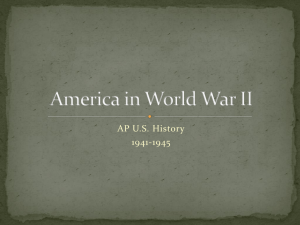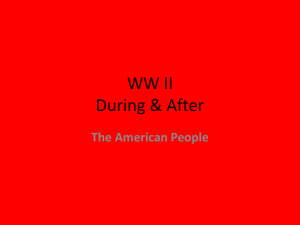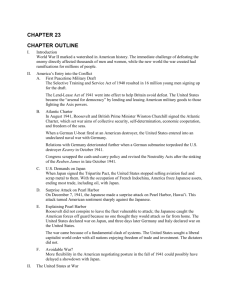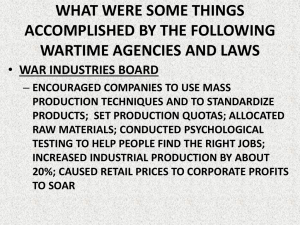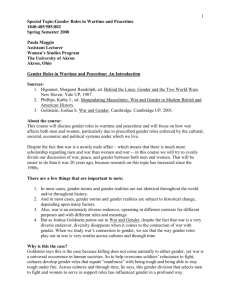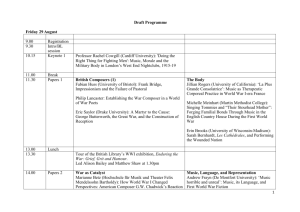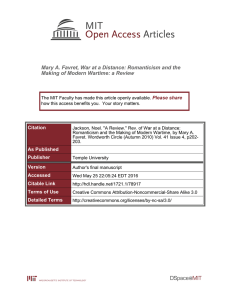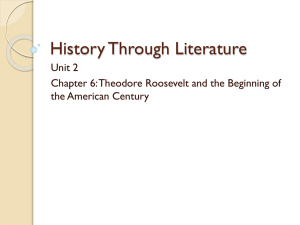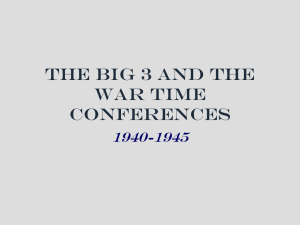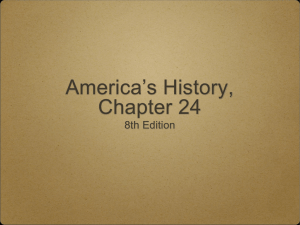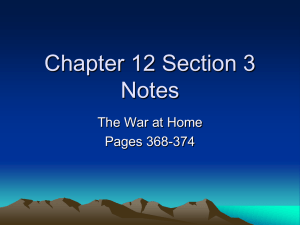File - Ms. Shauntee
advertisement
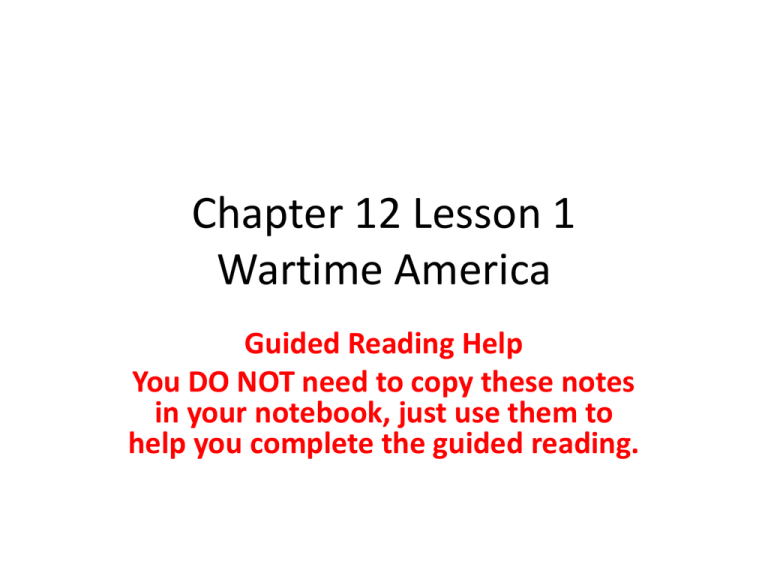
Chapter 12 Lesson 1 Wartime America Guided Reading Help You DO NOT need to copy these notes in your notebook, just use them to help you complete the guided reading. Building the Military • Question 1 • Within days of Germany’s attack on Poland in 1939, President Roosevelt expanded the army to 227,000 soldiers. Before the spring of 1940, many Americans had opposed a peacetime draft. Opinions changed after France surrendered to Germany in June 1940. In September of that year, Congress approved the Selective Service and Training Act—a plan for the first peacetime draft in American history—by a wide margin. Building the Military • Question 2 • At the start of the war, the U.S. military was segregated. • In early 1941, the air force created its first African American unit, the Tuskegee Airmen. Commanded by Lt. Colonel Benjamin O. Davis, Jr., the squadron helped win the Battle of Anzio in Italy. Three other Tuskegee squadrons protected American bombers as they flew to their targets. Building the Military • Question 3 • Many women were unhappy that WAAC was not part of the regular army, however. About a year later, the army replaced the WAAC with the Women’s Army Corps (WAC). • The coast guard, navy, and marines followed suit and set up women’s units. About 300 women serving as Women Airforce Service Pilots (WASPs) made more than 12,000 flights to deliver planes to the war effort. American Economy in Wartime • Question 4 • War production increased rapidly after the attack on Pearl Harbor, helped by existing government plans to build thousands of warplanes and a “Two-Ocean” navy. American Economy in Wartime • Question 5 • The government asked businesses to work with them in getting ready for the war. Because this was a slow process, the government signed costplus contracts, agreeing to pay a company the cost to make a product plus a guaranteed percentage as profit. Under the cost-plus system, the more—and faster—a company produced, the more money it made. Although not cheap, the system got war materials produced quickly and in quantity. American Economy in Wartime • Question 6 • The automobile industry was uniquely suited to mass-producing military goods. Automobile plants began making trucks, jeeps, and tanks. Mass production was critical because the country that could move troops and supplies most quickly usually won the battle. American Economy in Wartime • Question 7 • Ford’s remarkable achievement in aircraft production was more than matched by Henry Kaiser’s shipyards. German submarines were sinking American cargo ships at a terrifying rate. Kaiser’s shipyards built many kinds of ships, but they were best known for basic cargo ships called Liberty ships. American Economy in Wartime • Question 8 • As war production grew, controversies between business leaders, government agencies, and the military increased. President Roosevelt created the War Production Board (WPB) to direct priorities and production goals. Later he set up the Office of War Mobilization to settle disputes among the different agencies. Life on the Home Front • Question 9 • When the war began, American defense factories wanted to hire white men. With so many men in the military, however, there simply were not enough white men to fill all of the jobs. Under pressure to produce, employers began to recruit women and minorities. Life on the Home Front • Question 10 • Factories hired women, but they resisted hiring African Americans. Frustrated by the situation, A. Philip Randolph, the head of the Brotherhood of Sleeping Car Porters—a major union for African American railroad workers—decided to act. He informed President Roosevelt that he was organizing a march on Washington “in the interest of securing jobs . . . in the national defense and . . . integration into the . . . military and naval forces.” Life on the Home Front • Question 11 • On June 25, 1941, Roosevelt issued Executive Order 8802, which stated, “there shall be no discrimination in the employment of workers in defense industries or government because of race, creed, color, or national origin.” To enforce the order, he created the Fair Employment Practices Commission, the first federal civil rights agency since Reconstruction. A Nation on the Move • Question 12 • The wartime economy created millions of new jobs, leading 15 million Americans to move to find work. The growth of southern California and cities in the Deep South created a new industrial region—the Sunbelt. A Nation on the Move • Question 13 • When Japan attacked Pearl Harbor, many Americans turned their anger against Japanese immigrants and Japanese Americans. Most of the West Coast was declared a military zone, and people of Japanese ancestry were evacuated to 10 internment camps farther inland. • All unnaturalized residents of German and Italian descent aged 14 years or over were deemed enemy aliens and subject to regulations including travel restrictions and the seizure of personal property. More than 5,000 were arrested and sent to live in military internment camps. Daily Life in Wartime • Question 14 • High demand for raw materials and supplies created shortages. OPACS began rationing, or limiting the purchase of, many products to make sure enough were available for military use. Daily Life in Wartime • Question 15 • The federal government spent more than $300 billion during World War II—more money than it had spent from Washington’s administration to the end of Franklin Roosevelt’s second term. Congress raised taxes, although not as high as Roosevelt requested due to public opposition to large tax increases. As a result, the extra taxes collected covered only 45 percent of the war’s cost. The government issued war bonds— more than $100 billion worth was sold to individuals, banks, and other financial institutions—to make up the difference. Summary and Reflection • Question 16 • In order to fully answer the question make sure you include in 3-4 sentences: – What Roosevelt did to prepare for war. – Peacetime draft – How were businesses involved? – Who worked when the men went to war? – How did the government raise money?
